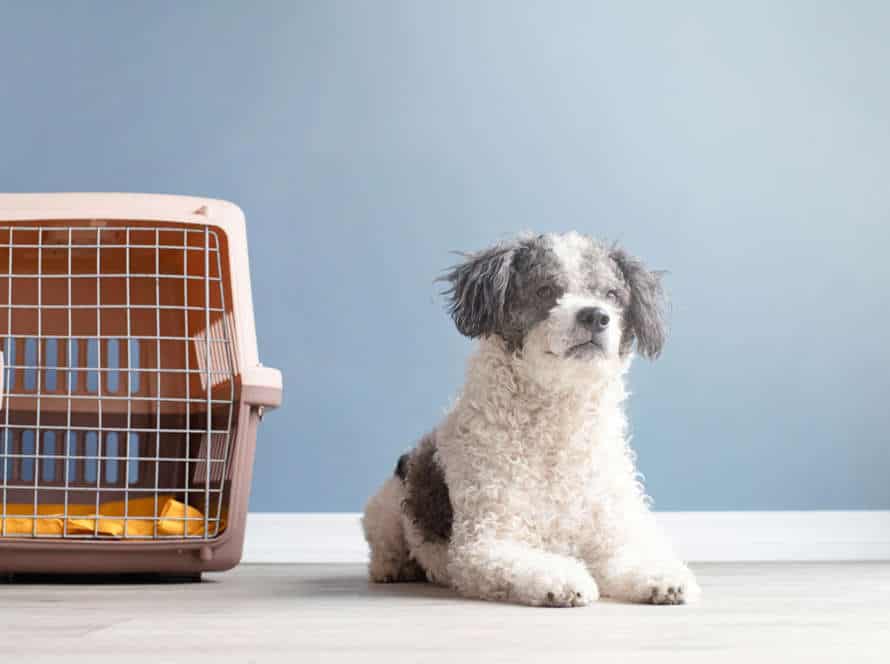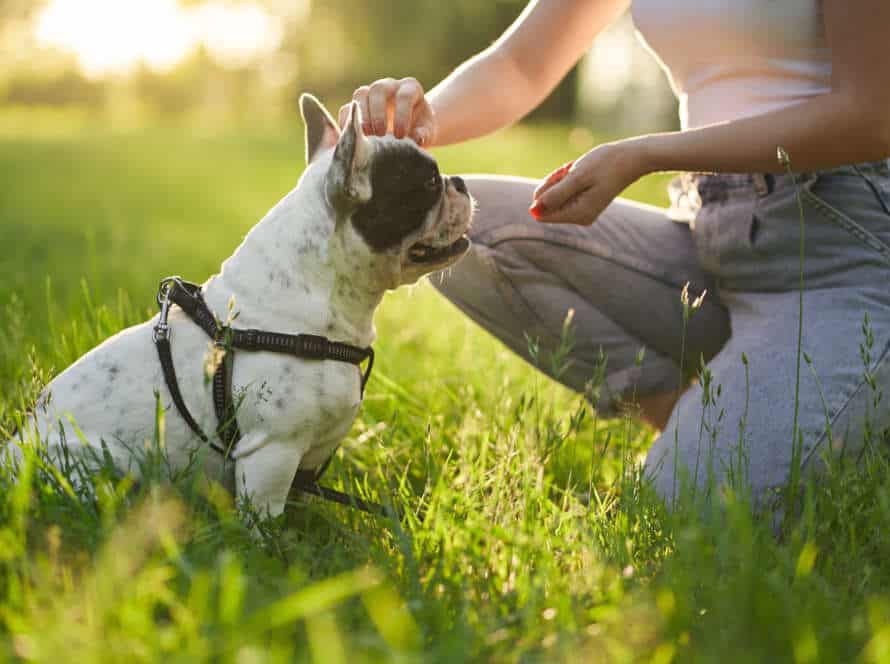Desensitization and Counter-Conditioning for Leash Reactive Dogs
Desensitization and counter-conditioning are successful techniques to manage leash reactivity in dogs. Desensitization requires exposing your pup to triggers, like other canines or loud noises, in a monitored and secure atmosphere. Increase the intensity of exposure over time. Counter-conditioning means adjusting your dog’s emotional response to those triggers, from negative to positive. Link them with something positive or gratifying.
These are the fundamental actions in desensitization and counter-conditioning for leash reactive dogs:
- Recognize the triggers which cause your dog to respond on a leash.
- Make a managed atmosphere, for instance a silent park, where you can expose your dog to those triggers from a protected distance.
- Reward your canine with treats or toys any time they demonstrate peaceful behavior in the presence of the triggers.
- Gradually raise the intensity of exposure over time, always awarding calm behavior.
- With determination and regularity, desensitization and counter-conditioning can assist your pup to conquer their leash reactivity and relish walking on a leash.
Understanding Leash Reactivity
Leash reactivity can be a vexing problem for dog owners. To understand how to manage it, it’s important to know its causes and triggers. Fear and frustration are common causes and often lead to an increase in arousal. In this section, we’ll explore the causes of leash reactivity and discuss how to address it.
Identifying leash reactivity triggers
It’s important to find out what triggers your leash reactive pup. Here are some common ones:
- Other dogs. Fear, excitement, or aggression can cause leash reactivity when they spot or hear other doggos.
- People. When they meet unfamiliar people, some pups get reactive if the person moves too close or quickly.
- Noises. Loud or sudden sounds such as cars, bikes, or slamming doors can trigger leashing up.
- Movement. Fast-moving objects like skateboards, bikes, or scooters can make them act up.
Once you know what sets off your pooch, you can start using desensitization and counter-conditioning techniques to help them overcome it.
Common behaviors of leash reactive dogs
Leash reactivity is a problem for some pups. Here are some signs to look out for:
- Barking or growling at other dogs/people
- Lunging or biting
- Pulling on the leash
- Hiding behind their owners
- Excessive panting, drooling, or shaking
To address and manage leash reactivity it’s important to use desensitization and counter-conditioning techniques. Desensitization is exposing the pup to the trigger gradually, in a controlled environment. Counter-conditioning works to change the pup’s emotion response to the trigger. With patience and consistency, owners can manage leash reactivity and improve behavior.
Negative consequences of leash reactivity
Leash reactivity can bring many bad outcomes for both dogs and their owners. Such as barking, growling, lunging, or displaying aggression when on a leash and encountering other dogs or people. This can be risky, stressful, and mortifying for owners. Also, it can cause harm to both dogs and humans.
Moreover, leash reactivity can affect the mental health of dogs. They may be apprehensive or scared around other dogs or people, which can reduce their quality of life. So, it is important to treat leash reactivity through desensitization and counter-conditioning to help the dog’s behavior and overall wellbeing.
Desensitization and Counter-Conditioning: The Basics
Desensitization and Counter-Conditioning (DCC) is a way to train dogs to stop behaviors like leash reactivity. Techniques like rewards and distractions are used to make dogs feel more comfortable in certain situations and environments. In this article, we’ll discuss the basics of DCC and how it can help your dog stay relaxed and more manageable on the leash.
What is desensitization?
Desensitization is a behavior modification method that attempts to reduce fear and anxiety in pups. To do this, they are gradually exposed to the causes of their reactive behaviors.
Here’s the process:
- Identify what causes your dog to react, i.e. another pup on a leash.
- Begin by having the trigger at a distance where your dog can see it without reacting.
- Reward them with treats and positive reinforcement when they stay calm.
- Then, gradually decrease the distance between your pup and the trigger. One step at a time!
- If your pup gets anxious or reactive, stop the training session.
- Once they are calm again, resume the session at the same distance they were able to stay calm.
What is counter-conditioning?
Counter-conditioning is a way to change how somebody feels about a certain thing. It means linking the thing to something good, so they respond positively.
Desensitization and counter-conditioning are often used together to help dogs who are reactive on a leash. Desensitization means exposing the dog to the thing at a safe distance, and counter-conditioning means offering treats and praise when they’re close to the thing.
By doing this over and over, the dog’s feelings will change from scared or angry to relaxed and happy.
If you have a dog that’s reactive on a leash, get help from a professional dog trainer who knows how to do desensitization and counter-conditioning. With the right approach, patience, and consistency, you can help your pup love walking outside.
How do desensitization and counter-conditioning work together?
Desensitization and counter-conditioning are two training techniques. They work together to help dogs conquer fear, anxiety, and reactive behavior.
Desensitization’s goal is to gently introduce the dog to the trigger (like other dogs). It’s done in a controlled and positive way. Counter-conditioning aims to change the dog’s emotional and behavioral response to the trigger.
To use these techniques together, expose the dog to the trigger from a distance. When the dog is comfortable, the distance can be decreased. Reward the dog for their calm behavior to create positive associations with the trigger.
By using desensitization and counter-conditioning together, your dog can become less reactive and more comfortable around triggers that once caused them fear and anxiety.
Implementing Desensitization and Counter-Conditioning
Desensitization and counter-conditioning are two of the most common approaches to help leash reactive dogs. You can use these techniques to teach your dog to connect good things with the presence of other dogs and people.
Let’s take a closer look at how to employ desensitization and counter-conditioning for leash reactive dogs.
Creating a desensitization and counter-conditioning plan
Creating a plan for desensitization and counter-conditioning can help reduce or eliminate leash reactive behavior in your dog.
Desensitization is exposing your dog to the trigger that makes them react aggressively on a leash. Counter-conditioning is changing their emotional response to the trigger.
These steps can help:
- Figure out what causes your dog to react on a leash.
- Begin with a low-intensity version of the trigger, then slowly increase intensity.
- Give something your dog loves, like treats or playtime, when showing the trigger.
- Keep repeating the process until your dog is desensitized and doesn’t react.
Patience and consistency is key. With persistence, you can manage leash reactive behavior and create a calmer, happier dog.
Working with a professional trainer or behaviorist
A professional trainer or behaviorist is essential for implementing desensitization and counter-conditioning techniques for a leash reactive dog. (existing)
They have the expertise and experience to assess the dog’s behavior and create a personalized plan. Desensitization and counter-conditioning can help the dog overcome their fear triggers on walks.
- Desensitization is exposing the dog to their triggers at a low intensity.
- Counter-conditioning replaces unwanted behaviors with positive responses.
A professional can:
- Evaluate the dog’s behavior and create a personalized training plan.
- Teach how to read the dog’s body language and respond when they show anxiety or fear.
- Help develop a consistent training routine to reinforce positive behaviors.
- Encourage the dog to feel more relaxed and comfortable on walks.
Common challenges and how to overcome them
Desensitization and counter-conditioning are good strategies for leash-reactive dogs. But, there can be certain problems. Here are a few common issues and tips to sort them out:
- Moving too fast: Start with a distance and intensity that is okay for your pup. Increase it over time. If you rush, it can cause stress.
- Inconsistency: Be consistent. Use the same techniques, be consistent with the routine. This will help your pup and prevent backsliding.
- Overwhelming stimuli: If your dog looks overwhelmed, take a step back. Then start at a lower intensity or distance. Slowly work up to the desired level.
Be mindful of those challenges and use the right methods to overcome them. That way you can successfully implement desensitization and counter-conditioning techniques for your leash-reactive dog.
Advanced Techniques for Desensitization and Counter-Conditioning
Desensitization and counter-conditioning are two advanced strategies used to change behavior in leash reactive dogs. Desensitization is when the dog is gradually exposed to a problem stimulus. Counter-conditioning is a technique that changes the dog’s feelings towards the stimulus. These two methods together can help leash reactive dogs have a positive response to the stimulus.
Gradual exposure and shaping
Gradual exposure and shaping are two powerful tools for desensitizing and counter-conditioning leash reactive dogs.
- Gradual Exposure: Slowly introduce your dog to its triggers in a safe space. Start with low intensity and up the ante as your pup gets more comfortable.
- Shaping: Break down complex behaviors into smaller, achievable steps. For leash reactive dogs, this could look like having them look at you, then away from the trigger, then eventually closer to the trigger over time.
Pro Tip: Always consult a professional before using these techniques to keep you and your pup safe!
Adding distractions and difficulty levels
Adding distractions & difficulty levels is essential for desensitization & counter-conditioning with leash reactive dogs. The purpose? Making them feel safe near their triggers.
To add distractions:
- Begin with low-intensity triggers. Increase their intensity & duration over time.
- Add new triggers – like people, animals, objects.
- Train in different environments & situations to generalize the behavior.
To add difficulty levels:
- Teach basic commands.
- Introduce distractions & train your dog to focus.
- Increase difficulty by increasing proximity or intensity of the distraction.
- Reward your dog every time he responds positively.
Patience & consistency are key. Pro tip: Seek help from a professional trainer.
Incorporating positive reinforcement and rewards
Positive reinforcement & rewards can be a great way to desensitize & counter-condition leash-reactive pups. Here’s how it’s done:
- Identify what triggers your dog’s reaction while on a leash.
- Train them to associate those triggers with positive experiences. Start by exposing them to the trigger at a distance & reward them when they stay calm.
- Gradually reduce the distance & keep rewarding them when they stay calm.
- Over time, they’ll link the trigger to positive experiences & their reactivity will lessen.
Remember, desensitization & counter-conditioning take time & patience. A pro trainer can help you make a plan to meet your pup’s needs.
Measuring Success and Continuing Training
Desensitization and counter-conditioning of leash reactive dogs needs to be monitored. Progress must be measured and a special training plan designed for each pup. Let’s look at how to track success, create a plan and keep training.
Tracking progress and success
When using desensitization and counter-conditioning to ease leash reactivity, tracking your dog’s progress is important. Here’s how:
- Keep a journal or logbook to record your dog’s behavior during walks and any interventions used.
- Set up a system to track intensity (barking, lunging, growling) and environmental triggers (other dogs, people, cars).
- Set achievable goals for your dog’s progress – like reducing leash reactivity frequency or intensity.
- Use the logbook to assess behavior and make adjustments.
- Remember: consistency is key when training a leash reactive dog. Tracking progress helps you stay on track and celebrate successes.
Adapting the training plan as needed
Desensitization and counter-conditioning training can be useful for leash-reactive dogs. It’s important to adjust the plan for success.
Monitor progress and change the plan if needed.
Gradually increase difficulty.
Use positive reinforcement to reward good behavior and encourage progress.
If struggling, get help from an expert.
Be patient and consistent. Desensitization and counter-conditioning take time to work.
Continuing desensitization and counter-conditioning skills throughout the dog’s lifetime.
Desensitization and counter-conditioning are important for leash reactive dogs. To measure success and ensure lasting results, these techniques must be a life-long practice. Here are a few tips for continuing the process:
- Regular assessments – Regularly check your dog’s responses to triggers. Improvement shows you’re doing things right.
- Reinforcing behavior – Once desensitized, reward and reinforce good behavior to make it an automatic reaction.
- Gradual exposure – Too much too soon can overwhelm your pup. Start low and increase intensity based on their reactions.
- Continued training – Continue training the whole life to keep progress and possibly improve even more. Every dog is different, so adjust techniques to fit their needs.
- Pro tip – Don’t give up! Consistency is key. With patience, you’ll see results.
Frequently Asked Questions
1. What is desensitization and counter-conditioning for leash reactive dogs?
Desensitization and counter-conditioning are training techniques used to help dogs who react negatively, such as pulling or lunging, when they are on a leash. They involve gradually exposing the dog to the triggering stimuli while rewarding them for calm behavior, ultimately changing their emotional response.
2. How long does it take to desensitize a dog that is leash reactive?
The duration of the desensitization process varies depending on the severity of the dog’s reactions and the consistency of training. It can take several months of daily training sessions to see improvement.
3. Is desensitization and counter-conditioning effective for all dogs?
While these techniques are suitable for most dogs, it’s essential to work with a professional dog trainer or behaviorist to determine if the methods are suitable for your dog’s needs.
4. Can desensitization and counter-conditioning cure leash reactivity completely?
Desensitization and counter-conditioning can significantly reduce leash reactivity or eliminate it altogether. However, it’s essential to continue maintenance training to prevent regression and ensure long-term success.
5. How can I start desensitization and counter-conditioning my leash-reactive dog?
You can begin by gradually introducing your dog to the trigger stimuli, such as other dogs or bicycles, from a distance and rewarding them with high-value treats for calm behavior. The distance between your dog and the stimulus should gradually decrease as they become more comfortable.
6. Can I do desensitization and counter-conditioning at home, or do I need to work with a professional?
While some basic techniques can be done at home, it’s crucial to work with a professional dog trainer or behaviorist to ensure proper training and to make adjustments to the training plan based on your dog’s progress and needs.







